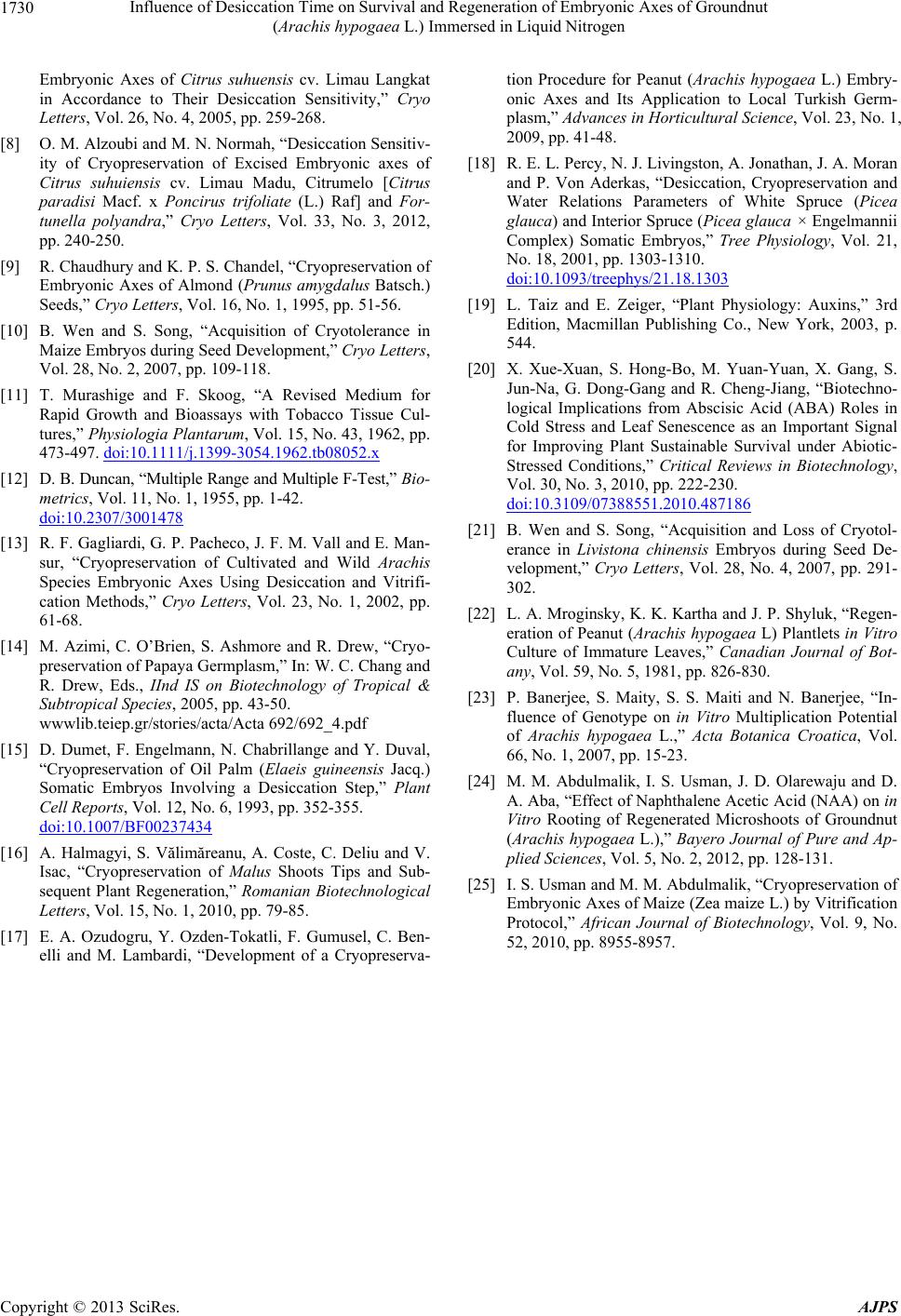
Influence of Desiccation Time on Survival and Regeneration of Embryonic Axes of Groundnut
(Arachis hypogaea L.) Immersed in Liquid Nitrogen
Copyright © 2013 SciRes. AJPS
1730
Embryonic Axes of Citrus suhuensis cv. Limau Langkat
in Accordance to Their Desiccation Sensitivity,” Cryo
Letters, Vol. 26, No. 4, 2005, pp. 259-268.
[8] O. M. Alzoubi and M. N. Normah, “Desiccation Sensitiv-
ity of Cryopreservation of Excised Embryonic axes of
Citrus suhuiensis cv. Limau Madu, Citrumelo [Citrus
paradisi Macf. x Poncirus trifoliate (L.) Raf] and For-
tunella polyandra,” Cryo Letters, Vol. 33, No. 3, 2012,
pp. 240-250.
[9] R. Chaudhury and K. P. S. Chandel, “Cryopreservation of
Embryonic Axes of Almond (Prunus amygdalus Batsch.)
Seeds,” Cryo Letters, Vol. 16, No. 1, 1995, pp. 51-56.
[10] B. Wen and S. Song, “Acquisition of Cryotolerance in
Maize Embryos during Seed Development,” Cryo Letters,
Vol. 28, No. 2, 2007, pp. 109-118.
[11] T. Murashige and F. Skoog, “A Revised Medium for
Rapid Growth and Bioassays with Tobacco Tissue Cul-
tures,” Physiologia Plantarum, Vol. 15, No. 43, 1962, pp.
473-497. doi:10.1111/j.1399-3054.1962.tb08052.x
[12] D. B. Duncan, “Multiple Range and Multiple F-Test,” Bio-
metrics, Vol. 11, No. 1, 1955, pp. 1-42.
doi:10.2307/3001478
[13] R. F. Gagliardi, G. P. Pacheco, J. F. M. Vall and E. Man-
sur, “Cryopreservation of Cultivated and Wild Arachis
Species Embryonic Axes Using Desiccation and Vitrifi-
cation Methods,” Cryo Letters, Vol. 23, No. 1, 2002, pp.
61-68.
[14] M. Azimi, C. O’Brien, S. Ashmore and R. Drew, “Cryo-
preservation of Papaya Germplasm,” In: W. C. Chang and
R. Drew, Eds., IInd IS on Biotechnology of Tropical &
Subtropical Species, 2005, pp. 43-50.
wwwlib.teiep.gr/stories/acta/Acta 692/692_4.pdf
[15] D. Dumet, F. Engelmann, N. Chabrillange and Y. Duval,
“Cryopreservation of Oil Palm (Elaeis guineensis Jacq.)
Somatic Embryos Involving a Desiccation Step,” Plant
Cell Reports, Vol. 12, No. 6, 1993, pp. 352-355.
doi:10.1007/BF00237434
[16] A. Halmagyi, S. Vălimăreanu, A. Coste, C. Deliu and V.
Isac, “Cryopreservation of Malus Shoots Tips and Sub-
sequent Plant Regeneration,” Romanian Biotechnological
Letters, Vol. 15, No. 1, 2010, pp. 79-85.
[17] E. A. Ozudogru, Y. Ozden-Tokatli, F. Gumusel, C. Ben-
elli and M. Lambardi, “Development of a Cryopreserva-
tion Procedure for Peanut (Arachis hypogaea L.) Embry-
onic Axes and Its Application to Local Turkish Germ-
plasm,” Advances in Horticultural Science, Vol. 23, No. 1,
2009, pp. 41-48.
[18] R. E. L. Percy, N. J. Livingston, A. Jonathan, J. A. Moran
and P. Von Aderkas, “Desiccation, Cryopreservation and
Water Relations Parameters of White Spruce (Picea
glauca) and Interior Spruce (Picea glauca × Engelmannii
Complex) Somatic Embryos,” Tree Physiology, Vol. 21,
No. 18, 2001, pp. 1303-1310.
doi:10.1093/treephys/21.18.1303
[19] L. Taiz and E. Zeiger, “Plant Physiology: Auxins,” 3rd
Edition, Macmillan Publishing Co., New York, 2003, p.
544.
[20] X. Xue-Xuan, S. Hong-Bo, M. Yuan-Yuan, X. Gang, S.
Jun-Na, G. Dong-Gang and R. Cheng-Jiang, “Biotechno-
logical Implications from Abscisic Acid (ABA) Roles in
Cold Stress and Leaf Senescence as an Important Signal
for Improving Plant Sustainable Survival under Abiotic-
Stressed Conditions,” Critical Reviews in Biotechnology,
Vol. 30, No. 3, 2010, pp. 222-230.
doi:10.3109/07388551.2010.487186
[21] B. Wen and S. Song, “Acquisition and Loss of Cryotol-
erance in Livistona chinensis Embryos during Seed De-
velopment,” Cryo Letters, Vol. 28, No. 4, 2007, pp. 291-
302.
[22] L. A. Mroginsky, K. K. Kartha and J. P. Shyluk, “Regen-
eration of Peanut (Arachis hypogaea L) Plantlets in Vitro
Culture of Immature Leaves,” Canadian Journal of Bot-
any, Vol. 59, No. 5, 1981, pp. 826-830.
[23] P. Banerjee, S. Maity, S. S. Maiti and N. Banerjee, “In-
fluence of Genotype on in Vitro Multiplication Potential
of Arachis hypogaea L.,” Acta Botanica Croatica, Vol.
66, No. 1, 2007, pp. 15-23.
[24] M. M. Abdulmalik, I. S. Usman, J. D. Olarewaju and D.
A. Aba, “Effect of Naphthalene Acetic Acid (NAA) on in
Vitro Rooting of Regenerated Microshoots of Groundnut
(Arachis hypogaea L.),” Bayero Journal of Pure and Ap-
plied Sciences, Vol. 5, No. 2, 2012, pp. 128-131.
[25] I. S. Usman and M. M. Abdulmalik, “Cryopreservation of
Embryonic Axes of Maize (Zea maize L.) by Vitrification
Protocol,” African Journal of Biotechnology, Vol. 9, No.
52, 2010, pp. 8955-8957.